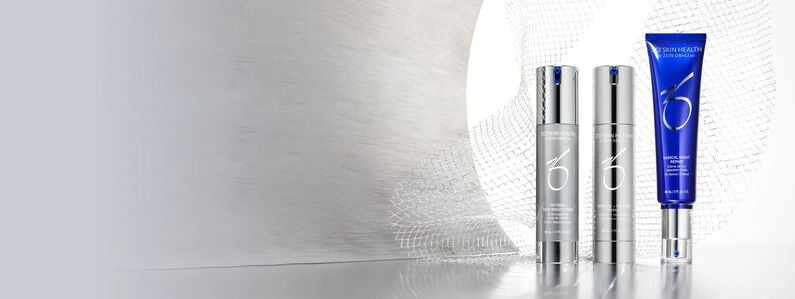Skincare Protocols | January 28 2025
The best ingredients for oily skin
Oily skin typically means that you produce too much natural oil which can result in multiple issues. There are a range of contributing factors that can also lead to an overly oily complexion including the environment, lifestyle, age, genetics, and hormones.
While your skin's natural oils can keep it youthful and hydrated, excess oil can lead to clogged pores, blemishes, and a shiny complexion. The key to managing oily skin lies in choosing the right skincare. But with so many products on the market, it can be challenging to know what ingredients are good for oily skin.
If you're unsure where to start, look at our guide to the best skincare for oily skin and discover ingredients specifically designed to balance oil production, reduce shine, and keep your complexion clear and healthy.
Salicylic acid
This is a type of beta hydroxy acid (BHA) that is oil-soluble, meaning it can penetrate deep into the pores. Salicylic acid is effective for oily skin as it has exfoliating properties that help clear excess sebum and dead skin cells that can cause blemishes. It's also an anti-inflammatory and can help reduce blemishes, blackheads, and discoloration caused by bacteria.
How should I use salicylic acid?
This ingredient can be found in some of the best skincare products for oily skin including cleansers, toners, exfoliators, and serums as well as in targeted spot and topical treatments. How you use it depends on the exact product you choose but it's typically recommended to follow these steps:
- Carry out a patch test: This should be done to make sure you don't have an allergic reaction or suffer irritation. Test the product on a small area of skin for three days and, if there is no reaction or irritation, use as normal.
- Wash the skin or, if using a cleanser, wet gently: This helps the product absorb into your skin and ensures a clean base.
- Apply the product as per the instructions: This could mean applying directly to the affected area or rubbing a cleanser into the skin in circular motions.
- Rinse and pat the skin dry: Avoid the eyes and mouth as you wash the product off your skin.
- Wash your hands: If you've used a cream, serum, gel, or topical treatment, ensure you thoroughly wash your hands.
ZO® Oily Skin products feature a range of exfoliating cleansers, serums, scrubs, and blemishes treatments to help you achieve an oil-free complexion.
Niacinamide
Niacinamide is a multi-tasking ingredient and a form of vitamin B3 that's used to address a variety of skin concerns. Niacinamide can help oily skin in multiple ways. As well as regulating oil production by reducing sebum, it can minimize the appearance of pores and improve texture. This wonder ingredient can also strengthen the skin's barrier, meaning you won't need to worry about stripping natural oils which can leave complexions dry and irritated.
Using niacinamide as part of your skincare routine
Niacinamide is often found as an ingredient in products for oily skin including cleansers, toners, and serums. It's generally well tolerated by all skin types and there's no right or wrong way to apply it, although it's important to always follow the instructions on the specific product you're using. Some people like to use it as a night-time serum or hydrator while others might prefer to apply it first thing in the morning as part of their skincare routine.
Clay
Clay is one of the oldest and most effective natural ingredients for controlling oil production. It can absorb excess oil from the skin’s surface without stripping it of its natural moisture, making it an effective ingredient for those prone to oily skin. Using clay as part of your skincare regimen can help prevent blackheads, whiteheads, and pimples.
The different types of clay
It's well-known that clay is one of the best ingredients for oily skin, but which type is the most effective?
- Kaolin: This is considered one of the gentlest exfoliants for sensitive skin so if you're new to using clay as part of your skincare, it might be a good one to start with.
- Green: This is great for reducing oils and impurities on blemish-prone skin and can help detoxify the complexion.
- Rhassoul: A popular type of clay that's often used in skincare products, rhassoul is great for removing toxins and bacteria. It's also mild so won't irritate or dry your skin.
- Bentonite: This is the strongest clay and is extremely effective at removing impurities, making it one of the best ingredients for oily skin. If you have very sensitive skin, choose a milder type or use it only occasionally to prevent excess dryness or irritation.
How to use clay as part of your routine
The most common way to reap the benefits of this natural mineral is by using a clay mask. These are typically applied to clean skin and left on for 10 to 20 minutes. The mask is rinsed off with warm water. If you have areas of dry skin, apply a hydrating serum afterward to lock in moisture and prevent irritation.
Hyaluronic acid
It’s a common misconception that oily skin doesn’t need hydration. Dehydration can cause the skin to produce even more oil to overcompensate and that's where hyaluronic acid comes in. This substance is produced naturally in the body and is an excellent property for combatting dryness. Often overlooked as one of the key ingredients for oily skin, hyaluronic acid helps to attract and retain moisture without clogging pores.
It's safe to use on most skin types but can be particularly beneficial for oily skin as it can help maintain a healthy production of those natural oils.
Using hyaluronic acid
You'll find this ingredient in a range of skincare products, including many suitable for oily skin including serums, hydrators, face masks, and creams. It can take time to see results and it's best to incorporate it as part of your targeted skincare routine.
Retinol
While this is a gold-standard ingredient for anti-aging, retinol is also good for oily skin. This is because, like hyaluronic acid, it can help maintain natural oil production and prevent dryness. One of the main benefits of retinol is its exfoliation properties, leading to a reduction of clogged pores, breakouts, and skin congestion.
How to use retinol as part of your regimen
Retinol can typically be used on all skin types, including oily skin, but it's recommended to build tolerance gradually if you're new to this ingredient. It's also important to follow the instructions on your chosen product. You'll find retinol featured in a range of skincare products including cleansers, creams, and serums which can be used daily once you've built up your skin's tolerance. ZO® Retinols include skin brighteners and repair creams that can help improve the skin's texture and appearance.
Combat an oily complexion with ZO® Skincare
Take a look at our Regimen Finder to find the best skincare products for your skin. For an individual approach to your skin concerns, use our finder tool to locate a ZO® Authorized Physician near you and discover targeted skincare and treatments. If you need general skincare advice or want to know more about the best ingredients for oily skin, you can use our Live Chat and speak to a Specialist.
Shop The Post
Wrinkle + Texture Repair
Out of StockAll Skin Types Anti-Aging TSA Approved
Retinol Skin Brightener 1%

All Skin Types Brightening AM or PM
Radical Night Repair
All Skin Types Anti-Aging TSA Approved



